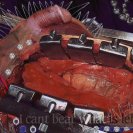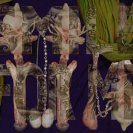The CD ROM Typhoid Mary was created on Macintosh computers at the College of Fine Arts, University of New South Wales from 1989 to 1991.
Photographic images were scanned and manipulated; a rough draft of the interactive structure was made with the software Hypercard and the final with Macromind Director. It can still be used on a Macintosh computer with a minimum 8 megabytes of free RAM, a 14 inch monitor and a stylewriter or laserwriter printer.
Linda Dement's digital tales of Typhoid Mary... takes its user into an uneasy zone where writing is stark and bleak, bled dry, and images are sensory overload. There is no freedom celebrated here. Everything is deliberate, made to function within the same constraints evoked by the materials: disease, depression, fear, fever, bondage, torture, addiction, the life of "a one-legged glowingly beautiful ex-whore..."1
A viewer can click anywhere on the image on screen. There is no apparent interface so they move blindly along the paths that connect images, animations, sounds, quotes, diary extracts, medical information, statistics and stories. Occasionally stories, which are not seen on screen, will print out. There is no hierarchy or order to the piece. The bodies of information orbit and loop and are connected by a multitude of active areas embedded in the imagery.
Assisted by the Art Research and Development Fund of the Australian Network for Art and Technology.
- 1. Sadie Plant; Zeros and Ones, Fourth Estate, London, 1997









